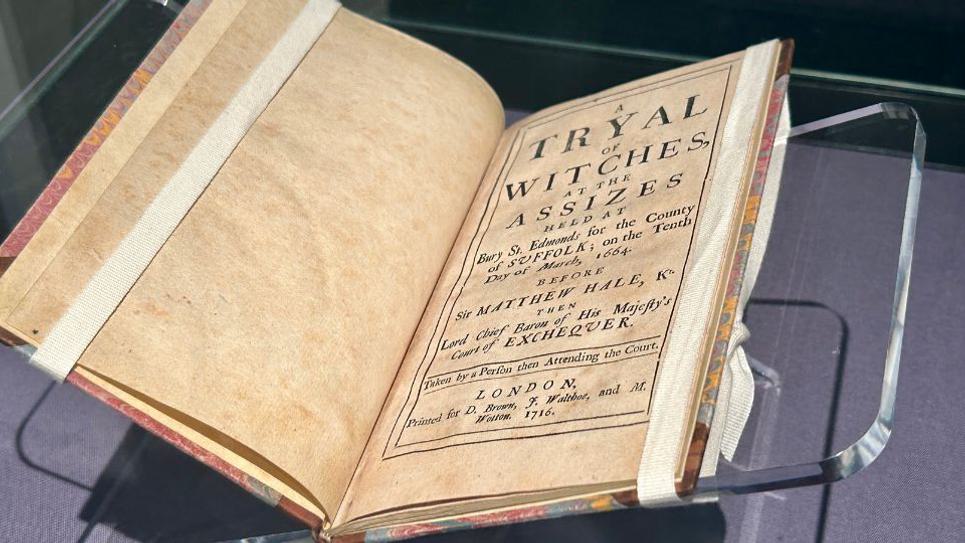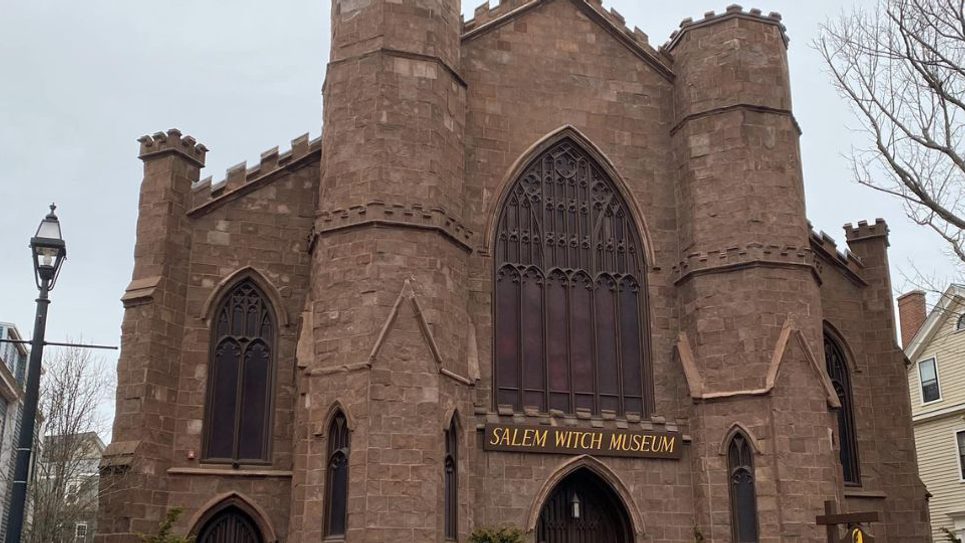
Back to Blogs
Discover
Town’s Museum Forms New Partnership with US Museum
Moyse’s Hall Museum will be forging links with a museum in Salem Massachusetts as part of a project to explore the shared history of the infamous witch trials.
Moyse’s Hall Museum will be forging links with a museum in Salem Witch Museum in Massachusetts

A Tryal of Witches Book on display at Moyse's Hall Museum
Moyse’s Hall Museum will be forging links with a museum in Salem Massachusetts as part of a project to explore the shared history of the infamous witch trials and encourage US visitors to the town.
The trial of Amy Denny and Rose Cullender, from Lowestoft, held in Bury St Edmunds in 1662 set a legal precedent that directly influenced the Salem witch trials in Massachusetts.
Information on these connections will go on display at both the Salem Witch Museum and at Moyse’s Hall Museum this winter. A series of lecture swaps is also planned with the Salem Witch Museum giving lectures to the Bury St Edmunds Museum audience and vice versa - creating a mutual exchange of knowledge and culture.
Moyse’s Hall Museum is currently curating an exhibition, due to open 31st October 2026, that will focus on the Witch Trials of Bury St Edmunds and East Anglia. This exhibition will share the victims’ stories, supported by a wider study of the early modern period to explore the reasons why the murderous witch trials may have occurred. The Museum, run by West Suffolk Council, will be working with academics from across the UK and the exhibition will feature loaned-in artefacts never seen on public display before.
The tragic story of Amy Denny and Rose Cullender, two elderly widows from Lowestoft accused, tried, and executed for witchcraft in Bury St Edmunds, is preserved in a historical booklet entitled 'A Tryal of Witches'. This document offers a detailed account of their 1662 trial, 20 years after their execution. Originally published in 1682 by an unknown author, a reprinted 1716 edition can now be seen at Moyse’s Hall Museum in Bury St Edmunds.
The 1682 booklet ‘A Tryal of Witches’ was consulted by Salem magistrates when determining what types of evidence were admissible. The trial directly influenced the legal thinking of Cotton Mather, a prominent minister during this time. The case is significant because it remains one of the most detailed records of an English witch trial and allowed “spectral evidence” from single uncorroborated witnesses.
Historian and Author Ivan Bunn, who wrote A Trial of Witches - a Seventeenth-century Witchcraft Prosecution with US criminologist Professor Gilbert Geis, notes that the Salem trials might not have taken place had it not been for the Bury St Edmunds trial.

Salem Witch Museum
Dan Clarke, Heritage Officer at Moyse’s Hall Museum, said: “Bury St Edmunds, within a witch trial context, is one of the most infamous places in Europe. To share our history in friendship and academic endeavour with the most notable place on earth for this study is very humbling. It’s a fascinating next step in our pursuit to best tell the human story of the victims in a wider context. We are grateful to the Friends of Moyse’s Hall and Bury Society for the purchase of the trial book, which has helped open the door for this exciting next chapter of study for our town.”
Bury St Edmunds holds the unfortunate distinction of having hosted the largest witch trial in English history.
Cllr Ian Shipp, Cabinet Member for Leisure at West Suffolk Council, said: “The witch trials is a disturbing part of our history in Bury St Edmunds that sadly carried over and influenced the United States. We already see many visitors from America to Moyse’s Hall which as a history museum reflects the good and bad from our past in order that we may learn from it. This link with Salem is the natural step for both museums and we look forward to exploring this further through our exhibits.”
Rachel Christ-Doane, Salem Witch Museum’s Director of Education, said: “We are excited about this collaborative opportunity, particularly because the roots of the Salem witch trials lie in England. We meet visitors from the UK regularly, many of whom have family connections to our local trials. We anticipate a fruitful exchange of information with Bury St. Edmunds as we compare the similarities and differences between these famous witchcraft panics.”
The transatlantic partnership between the two museums is part of a wider project in the town which seeks to highlight Bury’s darker history including the Bury St Edmunds witch trials.
Bury St Edmunds and Beyond, the town’s official tourism brand, ran a national digital marketing campaign last Autumn and Winter designed to capitalise on the rise of what is known as ‘Dark Tourism’. In March, Theatre Royal Bury St Edmunds staged their own in-house production A Tryal of Witches, which focused on the trials in the town. To coincide, Moyse’s Hall Museum curated an exhibition on Superstition: Strange Wonders and Curiosities along with a series of guest talks on the subject of witch trials, folklore, and superstition.
In addition, the town has many historical connections with the USA including Bartholomew Gosnold —founder of Cape Cod and Martha’s Vineyard in Massachusetts and Jamestown in Virginia. Bury St Edmunds had a pivotal role in the history of the Magna Carta, a charter of liberties on which the American Constitution is based. RAF Bury St Edmunds, now Rougham Airfield, welcomed 3,000 GIs, known as the Bomber Boys of the Mighty Eighth whose contribution to the Allies’ strategic bombing offensive helped turn the tide of war against the Nazis and free occupied Europe.
Sue Warren, Head of Marketing for Our Bury St Edmunds BID which operates the official tourism brand Bury St Edmunds and Beyond, said: “We are delighted that the two museums will be working in partnership. With direct ties to the Salem witch trials and as the hometown of Bartholomew Gosnold, Bury St Edmunds shares a fascinating and layered historical connection with the USA but in particular Massachusetts—one that continues to intrigue and attract American travellers seeking deeper stories from across the Atlantic.”
Related Blogs

News
Bury Tour Guides to launch…
Bury St Edmunds Tour Guides to Introduce new tours in…

News
Enjoy two months of…
Bury St Edmunds third Comedy Festival will bring two…

News
Vote for Bury St Edmunds in…
Last year we took home the UK's Most Dog Friendly Town…

News
Bury St Edmunds Tour Guides…
Tour Guides have been awarded the Travellers’ Choice…

News
Bury St Edmunds Parks Awarded…
The stunning Abbey Gardens and Nowton Park have both…
Latest news

News
Enjoy a Festive Afternoon Tea in 2025
Celebrate the Christmas season with a festive afternoon tea in Bury St Edmunds & Beyond...

News
Festive Winter Walks
Get outside and enjoy the fresh crisp winter air with one of these walks in Bury St Edmunds and Beyond!

News
Bury Tour Guides to launch new tours next year after successful 2025
Bury St Edmunds Tour Guides to Introduce new tours in 2026 and continue the successful Food and Drink Tours!

News
New in Bury St Edmunds For 2026
A sneak peak into new attractions visitors can enjoy in Bury St Edmunds in 2026.

News
Baby It's Cold Outside... Things To Do When the Weather Turns Frosty
Just because the temperature’s dropped doesn’t mean the fun has to! If you’re visiting town during the chillier months, there’s still plenty to see, do, and experience.

News
Places to sit by a roaring fire in Bury St Edmunds & Beyond
Warm up by a roaring fire this winter in Bury St Edmunds & Beyond...

News
Christmas Park and Walk 2025
Additional parking has been provided by West Suffolk Council in partnership with Greene King this Christmas.

News
Festive Theatre Guide 2025
There’s no better way to summon the magic of the festive season than a trip to the theatre.

News
Festive Markets in Bury St Edmunds
Festive markets are set to bring seasonal cheer to Bury St Edmunds this November and December, offering the perfect chance to pick up all of your Christmas essentials!
